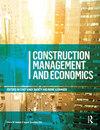Transforming construction: the multi-scale challenges of changing and innovating in construction
IF 3.3
Q2 BUSINESS
引用次数: 6
Abstract
What does “transforming” construction mean? – Where is it, who is doing the transforming, and how (and when) do we know it is happening? In Construction Management and Economics and elsewhere, there is a longstanding discussion amongst scholars on the topic of innovation in construction – but what of transformation in construction? Is it different, and if so – how? We set out with this Special Issue to answer these questions and advance the theoretical understanding of the transformation of the built environment, and how this requires the construction industry to transform accordingly. We believe that a “transforming construction” research agenda entails a multi-scalar perspective and therefore called for papers on industry-level transforming, firm-level transforming, and projectand programme-level transforming. We also recognise the process focus in contemporary social science through our framing of “transforming” construction as never-ending, and by seeking out accounts of how this is unfolding in practice. This resulting Special Issue will hopefully act as a provocation for new perspectives on transforming construction: it attempts to revisit, re-evaluate, and re-invent how we conceptualise both construction and construction research. The eight papers build on a strong legacy of research on innovation in construction management, while providing new insights on what is being transformed and how; locating, albeit tentatively, where the future debates are; and identifying spaces where rich data may be found. Readers will find a stimulating range of conceptual thinking and empirical evidence being brought to bear on change, innovation, and transformation, with extensive discussion of implications for future research on construction policy, projects, and people, broadening our field of view and drawing out strong new ideas to guide practice. The structure of this Editorial is as follows. First, we provide a synthetic recap of key themes within the transforming construction topic, as outlined in the Call for Papers. Secondly, we summarise the content of the eight accepted papers, positioning each paper under one of three headings, which reflect the multi-scale perspective of the Special Issue and as presented previously in the Call for Papers. We then go on to a discussion section, in which we set out what we see as five major themes emerging from the papers, characterising what transforming construction looks like from the perspective of these authors. There is a conclusion section to identify what the editorial team feels are the most pertinent reflections and questions, in a bid to offer some direction to future research in the area, followed by a short commentary on some limitations of the Special Issue.转型建筑:建筑变革与创新的多尺度挑战
“改造”建筑意味着什么它在哪里,谁在做转变,我们如何(何时)知道它正在发生?在《建筑管理与经济学》等书中,学者们长期以来一直在讨论建筑中的创新——但建筑中的转型呢?它不同吗?如果不同,如何不同?本期特刊旨在回答这些问题,推进对建筑环境转型的理论理解,以及建筑业如何进行相应的转型。我们认为,“转型建筑”研究议程需要多尺度的视角,因此需要关于行业层面的转型、企业层面的转型以及项目和计划层面的转型的论文。我们还认识到,通过我们将“改造”建筑视为永无止境的框架,并通过寻找实践中如何展开的描述,当代社会科学的过程重点。由此产生的特刊有望激发人们对建筑转型的新视角:它试图重新审视、重新评估和发明我们如何将建筑和建筑研究概念化。这八篇论文建立在对建筑管理创新研究的强大遗产之上,同时对正在发生的变化以及如何发生的变化提供了新的见解;确定未来辩论的地点,尽管只是试探性的;以及识别可以找到丰富数据的空间。读者将发现一系列关于变革、创新和转型的概念思维和经验证据,以及对未来建筑政策、项目和人员研究的影响的广泛讨论,拓宽了我们的视野,并提出了强有力的新思想来指导实践。这篇社论的结构如下。首先,我们对转型建设主题中的关键主题进行了综合回顾,如论文征集中所述。其次,我们总结了八篇被接受的论文的内容,将每一篇论文放在三个标题中的一个标题下,这反映了特刊的多尺度视角,正如之前在论文征集中所述。然后,我们进入讨论部分,在讨论部分,我们列出了论文中出现的五个主要主题,从这些作者的角度描述了改造建筑的样子。有一个结论部分来确定编辑团队认为最相关的思考和问题,以期为该领域的未来研究提供一些方向,然后对特刊的一些局限性进行简短评论。
本文章由计算机程序翻译,如有差异,请以英文原文为准。
求助全文
约1分钟内获得全文
求助全文
来源期刊

Construction Management and Economics
BUSINESS-
CiteScore
7.50
自引率
14.70%
发文量
58
期刊介绍:
Construction Management and Economics publishes high-quality original research concerning the management and economics of activity in the construction industry. Our concern is the production of the built environment. We seek to extend the concept of construction beyond on-site production to include a wide range of value-adding activities and involving coalitions of multiple actors, including clients and users, that evolve over time. We embrace the entire range of construction services provided by the architecture/engineering/construction sector, including design, procurement and through-life management. We welcome papers that demonstrate how the range of diverse academic and professional disciplines enable robust and novel theoretical, methodological and/or empirical insights into the world of construction. Ultimately, our aim is to inform and advance academic debates in the various disciplines that converge on the construction sector as a topic of research. While we expect papers to have strong theoretical positioning, we also seek contributions that offer critical, reflexive accounts on practice. Construction Management & Economics now publishes the following article types: -Research Papers -Notes - offering a comment on a previously published paper or report a new idea, empirical finding or approach. -Book Reviews -Letters - terse, scholarly comments on any aspect of interest to our readership. Commentaries -Obituaries - welcome in relation to significant figures in our field.
 求助内容:
求助内容: 应助结果提醒方式:
应助结果提醒方式:


